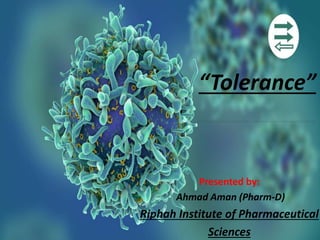
Immunological tolerance
- 1. “Tolerance” Presented by: Ahmad Aman (Pharm-D) Riphah Institute of Pharmaceutical Sciences
- 2. Tolerance: “Tolerance is specific immunologic unresponsiveness (i.e., an immune response to a certain antigen [or epitope] does not occur, although the immune system is otherwise functioning normally).” In general, antigens that are present during embryonic life are considered “self ” and do not stimulate an immunologic response (i.e., we are tolerant to those antigens). The lack of an immune response in the fetus is caused by the deletion of self-reactive T-cell precursors in the thymus.
- 3. Types of Tolerance: T Cell Tolerance Central tolerance (inside the thymus) Peripheral tolerance (outside the thymus) B Cell Tolerance Note: Although both B cells and T cells participate in tolerance, it is T-cell tolerance that plays the primary role.
- 4. Types of Tolerance: Tolerance to “self” acquired within the thymus is called central tolerance. Whereas, the tolerance acquired outside the thymus is called peripheral tolerance. ( mostly in spleen, lymph nodes) Peripheral tolerance is necessary because some antigens are not expressed in the thymus and therefore some self reactive T cells are not killed in the thymus.
- 6. Clonal Deletion: T lymphocytes acquires the ability to distinguish “self” from “non-self” in the fetal thymus by the process called clonal deletion. It is the process that involves the killing of T cells (“negative selection”) that react against antigens present in the fetus at that time. The self reactive cells die by a process of programmed cell death called apoptosis. For negative selection and clonal deletion to be efficient, the thymic epithelial cells must display a vast repertoire of “self ” proteins.
- 8. Clonal Deletion: A transcriptional regulator called the autoimmune regulator (AIRE) enhances the synthesis of this array of self proteins. The AIRE transcription factor also functions in the peripheral lymphoid organs such as the spleen and lymph nodes, where it contributes to peripheral tolerance. Mutations in the gene encoding the AIRE protein result in the development of an autoimmune disease called autoimmune polyendocrinopathy.
- 9. Polyendocrinopathy: APS type 1, also known as APECED (autoimmune polyendocrinopathy-candidiasis-ectodermal dystrophy). MEDAC (multiple endocrine deficiency autoimmune candidiasis syndrome). Juvenile autoimmune polyendocrinopathy. Whitaker's syndrome.
- 11. a) Vitiligo b) Alopecia Areata:
- 12. Clonal Anergy: “Clonal anergy is the term used to describe self- reactive T cells that are not activated because proper co-stimulation does not occurs.” Mechanism of clonal anergy: Inappropriate presentation of antigen, leading to a failure of interleukin-2 (IL-2) production. Inappropriate presentation is due to a failure of “co-stimulatory signals” For instance, sufficient amounts of IL-1 might not be made, or cell surface proteins, such as CD28 on the T cell and B7 on the B cell, might not interact properly, leading to a failure of signal transduction by RAS proteins.
- 13. Normal Activation of T cell:
- 14. Normal Activation of T cell:
- 15. Clonal Anergy: For example, the inhibitory protein CTLA-4 on the surface of the T cells may displace CD28 and interact with B7, resulting in a failure of T-cell activation.
- 16. Clonal Anergy: • Furthermore, B7 is an inducible protein, and failure to induce it in sufficient amounts can lead to anergy. • In addition, the co-stimulatory proteins, CD40 on the B cell and CD40L on the helper T cell, may fail to interact properly.
- 17. Clonal Anergy: The failure of co-stimulatory signals most often occurs when there is an insufficient inflammatory response at the site of infection. The presence of microbes typically stimulates the production of pro- inflammatory cytokines such as Tumor Necrosis Factor and IL-1. If the inflammatory response is insufficient (i.e. adjuvant effect of the cytokines is inadequate, the T cells will not be activated).
- 18. Clonal Ignorance: “Clonal ignorance refers to self-reactive T cells that ignore self antigens.” These self-reactive T cells are either kept ignorant by physical separation from the target antigens (e.g., the blood–brain barrier). Or ignorance to self antigens may occurs if the antigens are present in small amounts.
- 21. B-Cell Tolerance: B cells also become tolerant to “self” by two mechanisms: Clonal Deletion: probably while the B-cell precursors are in the bone marrow. Clonal Anergy: Of B cells in the periphery. Note: However, tolerance in B cells is less complete than in T cells, an observation supported by the finding that most autoimmune diseases are mediated by antibodies.
- 22. Clonal Deletion:
- 23. Clonal Anergy:
- 24. Receptor Editing: B cells bearing an antigen receptor for a self protein can escape clonal deletion (apoptosis) by a process called receptor editing. In this process, a new, different light chain is produced that changes the specificity of the receptor so that it no longer recognizes a self protein. This reduces the risk of autoimmune diseases and increases the repertoire of B cells that can react against foreign proteins. It is estimated that as many as 50% of self-reactive B cells undergo receptor editing. T cells do not undergo receptor editing.
- 27. Induction Of Tolerance: Whether an antigen will induce tolerance rather than an immunologic response is largely determined by the following: The immunologic maturity of the host: Neonatal animals are immunologically immature and do not respond well to foreign antigens. The structure and dose of the antigen: A very simple molecule induces tolerance more readily than a complex one. Very high or very low doses of antigen may result in tolerance instead of an immune response. Purified polysaccharides or amino acid copolymers injected in very large doses result in “immune paralysis” —a lack of response.
- 28. Induction Of Tolerance: Other aspects of the induction or maintenance of tolerance are as follows: T cells become tolerant more readily and remain tolerant longer than B cells. Administration of a cross-reacting antigen tends to terminate tolerance. Administration of immunosuppressive drugs enhances tolerance (e.g., in patients who have received organ transplants). Tolerance is maintained best if the antigen to which the immune system is tolerant continues to be present.